| Alternative re-entry of the Winter War volunteers .------ |
Counterfactual discourse or WHAT IF-study. .Historian Max Jacobsen wrote: "Many a modern day Byron on skies voluntarily appeared on the battleground, and though only a few* were at the frontline, in most western countries there are men, who with a little drop of sadness think of Finland as the one country they nearly did die for." Trotter, da. ed. p. 338. Danes of the Winter War: 1018 danes volunteered for active duty in the Finnish Army, mostly army officers and men and a dozen military pilots. The Danish Finland-Volunteers Battalion was formed in Oulu, neighbourghing the American Volunteers Battalion**. The force was partly finances by the Danish Finland Volunteers Society: Per-man equipment sums to Finland and travel. Prime contributors and negotiator facing a most reluctant danish government: The Copenhagen businessman H.P.Daehl (Daehls Varehus) and the shipowner, A.P.Møller (Now Mærsk). When after three month of hard fighting, 25.000 finns killed, 200.000 russsian, and finnish army reserves zero, by March 1. and 2., the colonel commanding the danish force was asked to commit two rifle coys (the Americans were asked for one coy) - he said no: The force still needed weapons... This turning down caused anger in all levels of the force. The finns had to sign a grim peace-treaty by March 12. 1940. Expecting fighting to break out again, they asked the danes to stay and moved the force south. Some 300 left during the week after the peace-treaty, among them the first CO (Battalion strengh by March 13th note 3 bottom). And some returned, when Denmark hersef was attacked by the Nazi-Germany on April 9. 1940. Cabinet"") Decision not to fight except for a symbolic couple of hours became a rough turn to the force (note 4). - Our source fifty years later left it to his listeners to do the experimental thinking by themselves: - 600 danes under arms and ready but 500 nautical miles away: What if you had been there yourself? This idea (source, see top front) of the early hours of Apr. 10th 1940 orbited among officers of the battalion. (This website do not discuss the history of individuals in any way of which some had nazi-sympaties, others certainly not) The scope of this "wargame" is to point out, that even this small force fighting the nazi-german invasion had served as an "eye-opener". |
|
|
II. AN OUTCOME WORTH CONSIDERING 1) had pointed out the sharp eastern bend to that Curtain right south of BORNHOLM - and 2) WOULD NOT May 7 or 8 have accepted the delay produced by Allied CO Europe Gen. Dwight D. Eisenhower when the British General "Dick" Dewing asked London for permission to fly to Bornholm to accept the german surrender after the russian bombings of Rønne and Nexø. GEN D. D. Eisenhower whatever his cause, see below, allowed for the russians - who didn´t answer telegrams for two days - to go there before Dewing and his men in Copenhagen. State Department anticipated that The Sovjet Occupation on Bornholm would lead to them requesting Base-Rights - precisely as with the finnish island of Hangö - in the negotiations of March 1940. If that should happend at Potsdam, State Department adviced that US negotiators NOT OPPOSE Sovjet demands. State wouldn't endanger the US Case for Greenland Base-Rights. That is: Don´t quarrel with Mr. Stalin over this baltic island. - Bornholm's the Danes' case - not a US one, unlike Narsarsuaq AB or Sondre Stroemfjord AB in Greenland on the western hemisphere. The Game we let loose is what the professionals TODAY call "Amphibian Warfare": Rule No. one: You must control the sea to come and go. In the early part of WWII we didn´t have the elaborated conceptions and experience. This is our SEA-C bid: Two warships, two disguised merchant vessels. First to land 1) to grap control of local telephone lines and 2) take out enemy patrol vessels to ensure our force be free to disengage in six days, were: Two Fast Reconnaissance Units, a Motorized Heavy Mortar Unit and a Demolition Engineers Unit. Enemy navy at Bornholm reduced to patrol boats because of ships lost at Norway sec. week of April. German forces on Bornholm est. 1.100 infantry. |
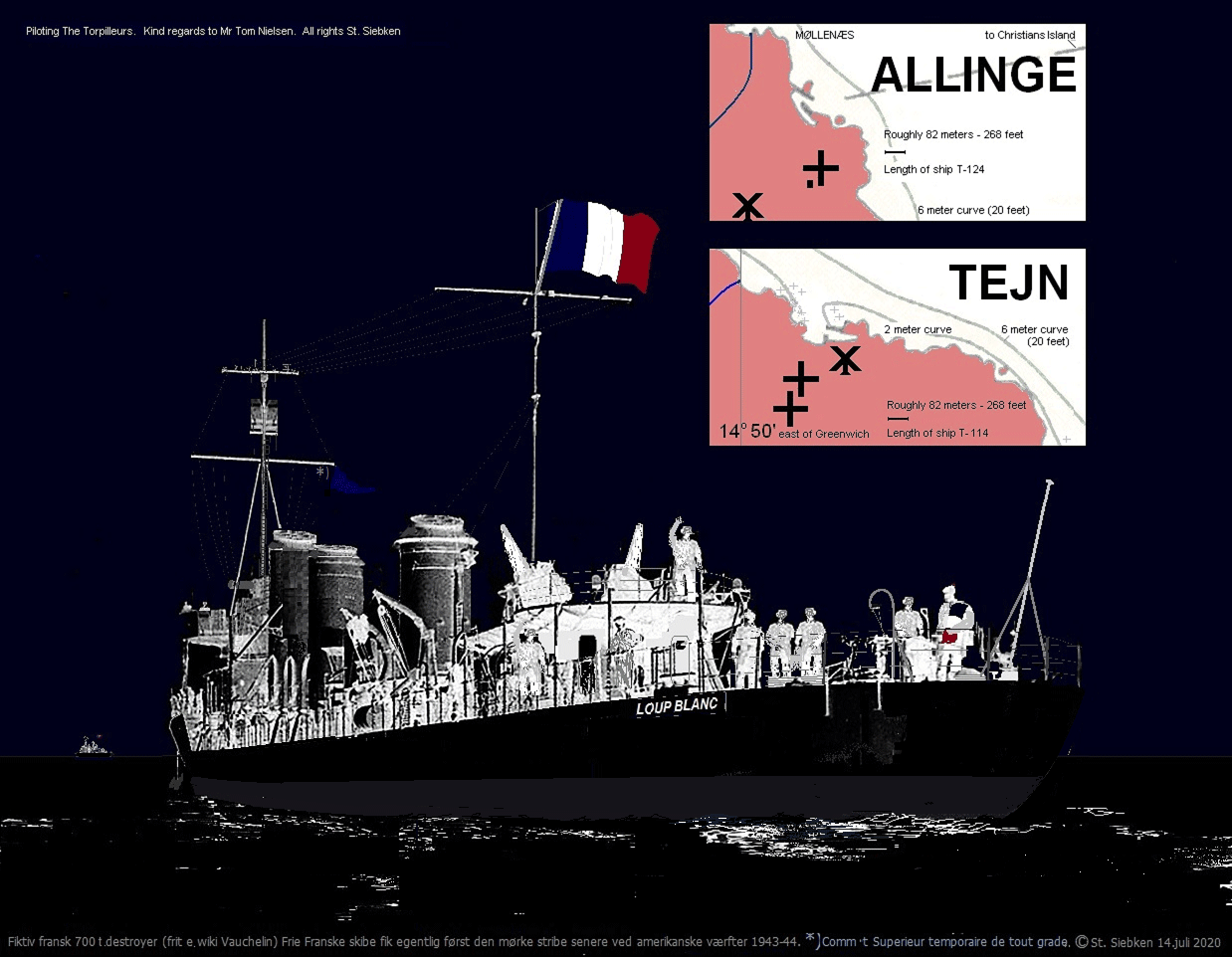
|
When I asked Mr. Tom Nielsen, harbourmaster in Tejn, in JanuarY 2010, he actually agreed that a small destroyer anno 1940 might sneak in, most vigilant of course, place the foreship across the entrance of the inner basin - in 1940 the only harbour basin - debark their troops and then back out using both propellers to steady the move; easy on the revolutions not to get propellers "dig down" the heck, and draught not exceeding 4 meters. That´s a vessel at roughly 700 tons deplacement like the french ships, or two by April '40 uncompleted at Copenhagen Navy Yard, the Nymfen and Najaden, at 710 tons, 200 tons less than the swedish "Ehrenskiölds" (sv. skibe scroll to image). Years ago his former college who also performed as a pilot told me that even bigger ships go in, if the skippers got the nerves: - In bad weather all you see from the sea will be the waves hammering the stones, you can´t hesitate, he said: - "Make some revolutions. Now ready to turn port and go reverse the moment you see the angle to the entrance open up!" By 1940 the outer pier and western basin were not built. Maps above show the old navigation marks, churches and windmills. |
CLAP THREE 00:22 MAY 3 - the morning after Christ's Ascencion which in Denmark is a public holiday
| The two Torpilleurs (700 tons depl) each embarked one reinforced jaeger compagny, six Nimbus motorcycles and three Morris C8 Quads#. HQ, B-coy and Support with six Ford 1937 buses, ten Morris C8 Quads (with 26 two-wheel ex-artillery 1-ton trailers, ready-loaded), two 1936 Ford Radio (ex-police) cars, one Pontiac and a GMC ambulance, six Triangel wood log trucks, two heavy mortars, 14 tons of rifle ammunition (40.000 7.62 rounds), 4 tons of mortar bombs and anti vehicle mines, 4 field radios of 52 pounds each, signal- and medical stores, 4.000 field rations, 18 tons of fuel and 40.000 cigarettes reached Gudhjem South Harbour with a 1.262 TDW ice-steamer on loan from war locked Aalborg Atlantic Shipping Co. (Jaeger coy.: fi. army vocabulary: Fast-moving rifle-coy. with bikes or skies) |
| The two Torpilleurs left the north east corner of Bornholm with first light. Since 01:45 AM they had disembarked troope. LOUP BLANC (illustration above) in Tejn/ Lynx Blanc in Allinge. Proceding together at 35 knots, north around the island to Rønne, bombarding for twenty minutes air strip and enemy base camp then through the Sound to Allied Skagerrak Force: 3 large french destroyers (autentic fact) only allied ships fast enough to meet german air power. The Danish Battalion moving uphill Bornholm numbers 662 off. and men. |
| III. THE GROUND BATTLE FACTS (HIST.) - By March 1940 Sovjet "Vojt", Josef Stalin, had enough of the diehard finnish army, as Jowlett & Snodgrass state. (Source: Osprey booklet: Finland at war, 1939-1945. 2006). Northern Europe 1940 or where the Hell is Bornholm? THE WHAT-IF GAME (FICTION) Infantry operating in southern scandinavian landscapes, even in the spring cannot be caught in motti like road-dependant russian units in snowcovered Mid-Finland. By May garden-owners finished digging. - This force prepare the battle ground: Minefields, meadow-swampings, wood cuts to redirect enemy troops, fire angels and evac air strips or havens. Right flank driving fast inland from Allinge, while left flank concentrate forces west and south west of Røø. Extract 0020 of Battalion War Diary of May 1940 A) May 3 GMT 2:20 A coy 4. platoon advanced inland along the stream to the Tileworks where two Volvo 38 TLV were taken. Cought up with 2.plt 47 off. & men carried, (bikes left as expendable). Motorized advance, best speed. A-coy HQ section [2 off. 1 nco radiooprator & 3 riflemen, messengers] found as planned two local taxies, a Buick 1931 soft top and a Fiat Convertìbile, once Cardinal Camillo´s, and caught up with the TLVs, GMT 3:52 1 kilometer (1 km = 0.6213 mile) south of Hammer Haven. KIA (killed in action) plus other casualties = 10.6 % (70). Wounded or injured evacuated prior to rearguard lift off. The comparatiely high losses among officers and NCOS were overcome by the four remaining CAPTAINS, Troost, Jorgensen, Mommsen and de Lamar Piffholm i.e. 3d, 4th, 5th and 6th in line of command, when the CO and the XO were killed during LUFTWAFFE air raids on Day 2. |
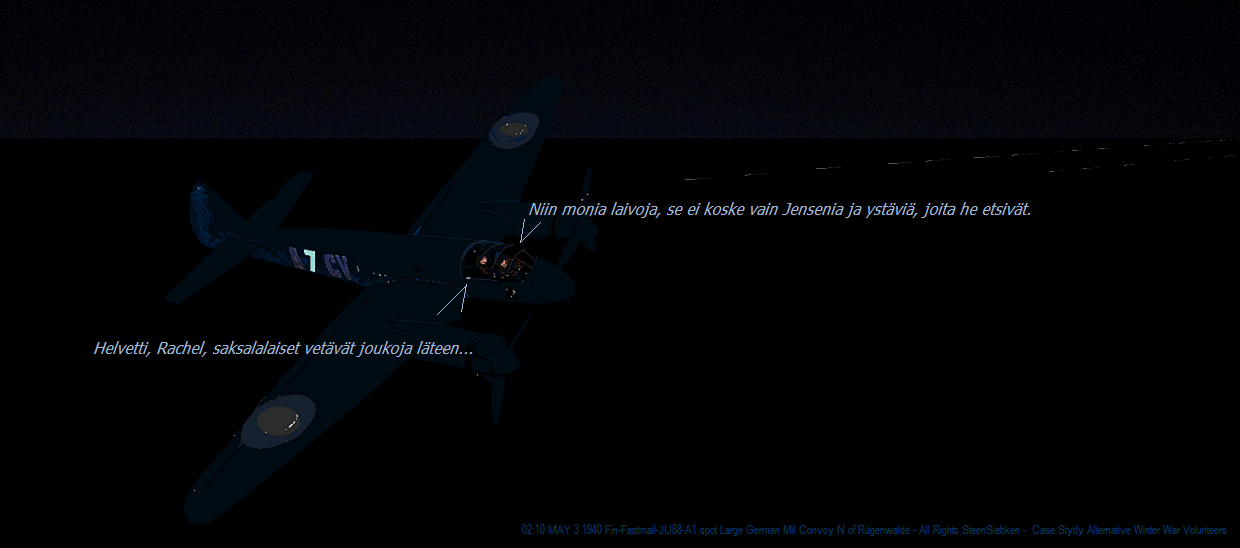
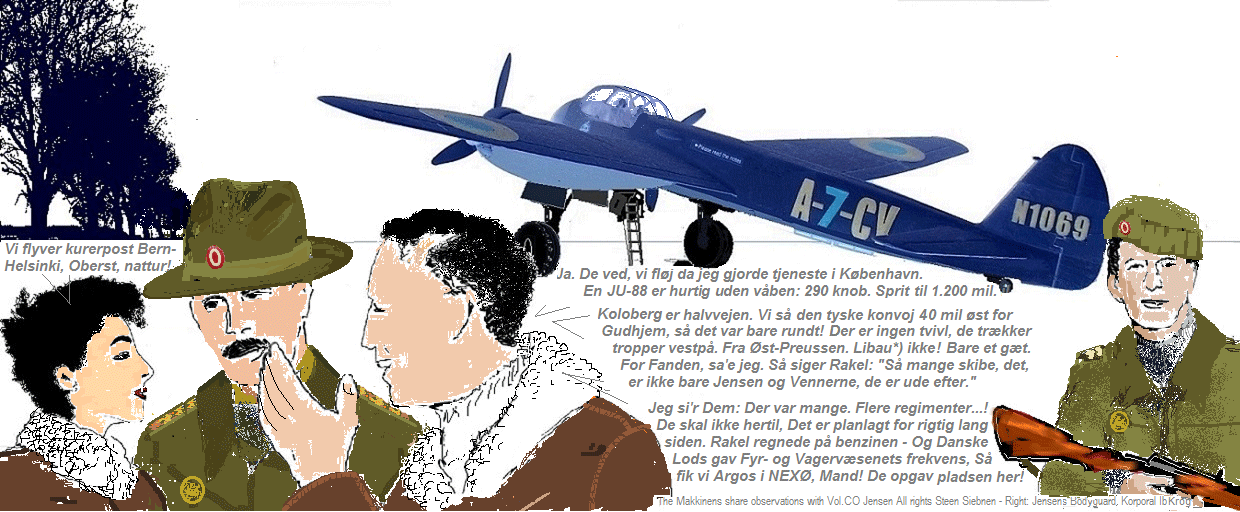
*) Autentisk information, der tilgik svensk efterretningstjeneste og ses af kildesamlingen "Transiteringsfrågan och därmed sammenhängande spörsmål, bind I, april - juni 1940", trykt 1947.
Illust. JU-88 er tegnet efter et foto af en Airfix model venligst udlånt redaktionen: En FINSK JU-88 A-4, se LINK page down (common wikipedia).
I 1940 var de tysk-producerede Junkers 88 (A1 og senere serier) blandt de hurtigste i Europa. JU-88 A4 tophast. 254 knob i 17.000 feet, sercice cieling 17.070 feet. aktionsradius 2.717 km.
efter:
Combat Aircraft, Taylor. "Fuel capacity" (A-4) 3.850 liter i flg. Manfried Griel, Junkers 88, s. 28.
|
IV. THE ART of getting out the men .DESPITE SET-BACKS mainly by the Luftwaffe, on May 6 this AWWV attack secured success. Strategically the Battle of Norway drained the Kriegsmarine. .AWWV-Intelligence scored by CORNER KICK when the screwschooner ALMA IV May 4 0.20 docked in NEXØ and reported Nazi concentration of troop transports .But wise IOs look both ways - The Boston Gazetteer and Casablanca-based La Vigie Marocaine - recognized the Campaign as proof the Wehrmacht was mortal. .*RED, WE FIGURE by The Foreign Legion´s 13. Demi-Brigade. When earmarked for Finland it ran "Sahara-Narvik-Brest", Svend R Christensen wrote in 1942. |
The drawing below shows our Fictive Reference Group 1: The Volunteers' Rearguard first part: TO-platoons with 61 officers and men and small civilian party awaiting evacuation by the ALMA diesel engined three mast schooner. (TO: the Finnish Army 1940 code for Light Reconnaisance Unit). |
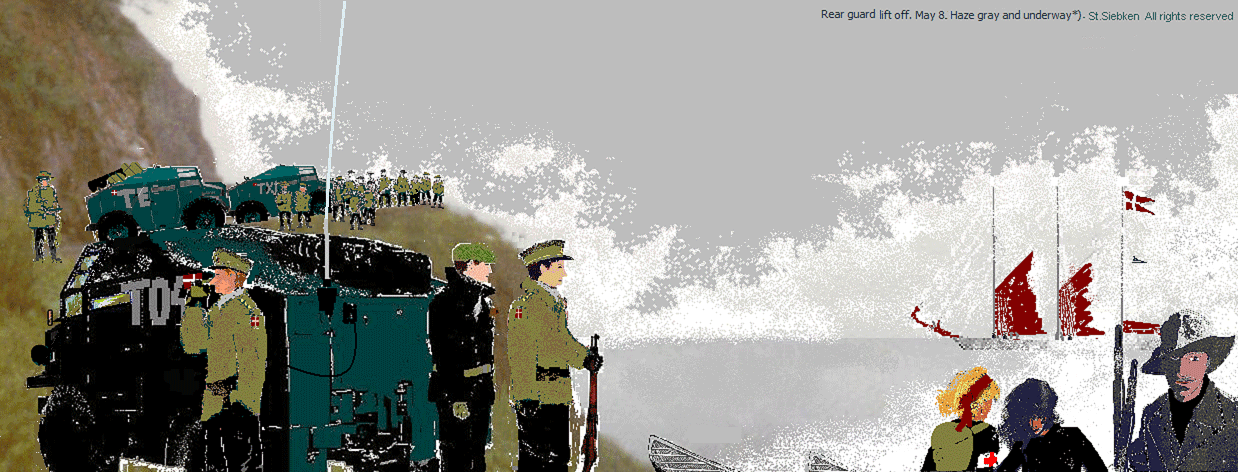
| To fetch our Fictive Reference Group 2, second and last part of the Volunteers' Rearguard (22 officers and men, 3 women + 1 she marten) one schooner-rigged former gasolin steam tanker, the DUNDAS, steering slowly west below a fluffy horison northeast of Hammeren, ready to become a surprisingly fast in-exile-smugler's-ferry for Our End Game. |
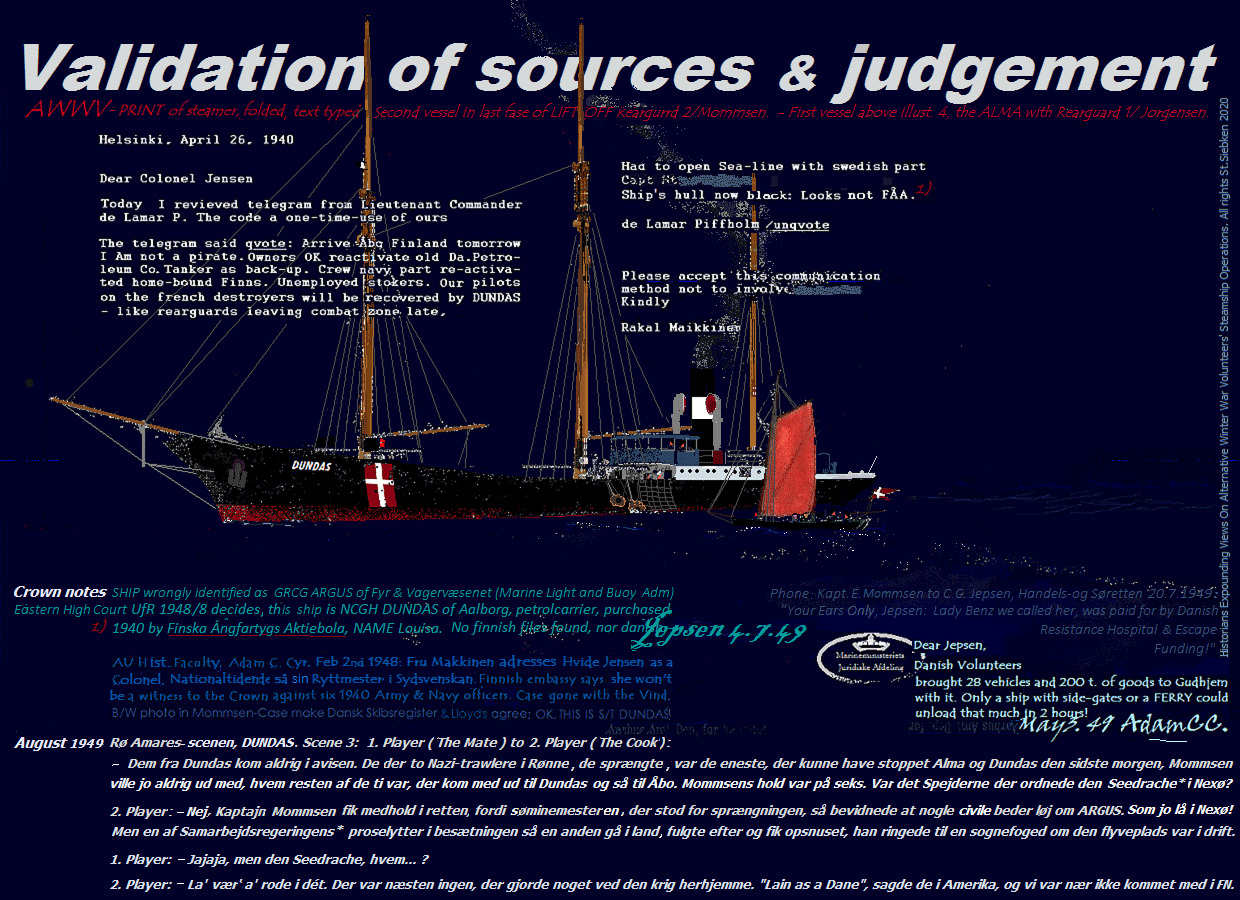
|
Note til Validation - SEEDRACHE - tysk flyvebåd, Bloom & Voss, BV-138
|
|
V. Cognitions of war The number of troops in this study are ONE to FOURTY of Gen. Dwight D. Eisenhower´s thump-rule "on the edge of too little", against the german army, autumn 1944. St. Siebken |
| VI. NOTES... |
| * One of them later left his white panted finnish army skies for my farther-in-law to use for the sport of it. - The Finland Volunteers, mr. Folmer Rasmussen, my bookdealer in the eightees once said: as a rule were older than us... By "us" he ment the Danish Resistance... Want of adventure and foreign experience were typical motives for danish officers. Wages symbolic, one must be economic independent. One example being Prince Aage of Rosenborg, who served as an officer of the French Foreign Legion. - Max Jacobsen quotation [top]: W. Trotter: Den finske Vinterkrig. 2004, page 338. ** Strengh (americans with finnish roots) differs between writers. But some did see action in the last days of the war. TOP if you want to... '3 Strenght of force March 13, commanding officer now LC J.H. Skjoldager, 944 = 35 officers 96 ncos and 813 men. 412 left before orders deployed the battalion as frontier guard at the Hangø Peninsula opposite to the island base now on russian hands. Strength of force March 18: 532 all ranks. Later some of those who left returned. (Source: I orkanens øje, Jan Ahtola Nielsen, 2006) At the 60 anniversary of the end of WWII, on the collaborationist government April 9 1940 to August 29 1943, danish prime, Anders Fogh Rasmussen marked War Era Collabotration with Nazi occupation force as "morally unjustificable".thus being the first danish prime to do so publicly.. source en.wiki |
| 30 Nov. 1939 -13 March 1940 The Winter War between Finland and Sovjet-Russia | This edition Alternative Re-entry Of The Winter... 1 Feb. 2024 All rights reserved Steen Siebken.. |